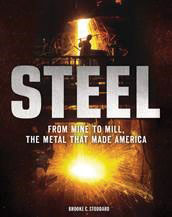Steel is the foundational material that gave rise to our modern civilization. From its use as piles in deep foundations; as reinforcing bars and anchor rods embedded in concrete and masonry structures; as structural shapes used as beams, columns, and braces; as bolts and light-gauge connectors in wood construction; and as light-gauge steel studs – steel is an essential and important part of our history and the modern built environment. Without steel, transportation via trains and automobiles would not exist and travel by water would be limited to small wooden vessels insignificant in size compared to the colossal steel-hull cargo vessels that transverse the oceans daily by the thousands. Without steel, bridge spans would be limited and notable bridges like the Golden Gate Bridge, Sydney Harbour Bridge, and the Brooklyn Bridge would not exist in elegant splendor like they do today. Skyscrapers, or structures of any significant height, would only exist in engineers’ dreams and imaginations if it was not for steel.
Brooke C. Stoddard has written an exceptional book that highlights the captivating history of steel and its use to create industries, generate wealth, and build nations. STEEL – From Mine to Mill, the Metal that made America is a fascinating and riveting read. Stoddard tells the story of steel from its assumed earliest discovery as iron meteorite fragments by man’s earliest ancestors to the mined and processed material we depend on in every facet of our daily lives. STEEL is a well-written and engaging history that covers centuries of experimentation, refinement, and improvement that resulted in the material we use today. Although an inanimate material, steel comes alive in this inviting and enthralling book. Stoddard does more than just write about the history of steel; he takes you on a well-researched adventure that highlights the material and the people that produce it. Not limited to just chronicling the distant past, STEEL contains modern historical information including methods of transportation and production. In the last chapter, you will learn about the reasons behind the decline of the steel industry in America and the influx of foreign steel.
Processes and procedures are written about with authenticity and accuracy because Stoddard rode in the trucks, cargo ships, and trains that transported the ore and he spent time in the factories talking to the people that produce the finished product. He captured the experience with great accuracy – enough to make the reader feel that they are participating in the same, vividly-described experiences with the author.
STEEL is a must read for any structural engineer. I found it a delightful book, a useful reference volume, and a welcome addition to my engineering library.▪

